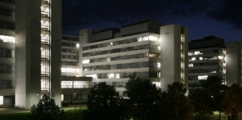| | | The soil fungus Rhizoctonia solani (teleomorph=Thanatephorus cucumeris) is an economically important pathogen of agricultural crops and a competitive saprobe that promotes the decomposition of organic matter. The fungus can also function as a beneficial endomycorrhizal symbiont of orchids to promote germination of orchid seeds and growth of orchid seedlings. The development of a well assembled and annotated genome sequence of the potato pathogen R. solani anastomosis group 3, field strain Rhs1AP, has been challenging. These challenges are related to the aneuploid chromosome and heterokaryotic, multinucleate nuclear condition of the vegetative mycelium, and difficulty in inducing the production of haploid basidiospores. To address this challenge, we developed an experimental approach to obtain isogenic strains with a reduced genomic complement (RGC) of parental strain Rhs1AP. Initially, a method was developed to obtain high quality protoplasts with reduced numbers of nuclei from mycelium of parental strain Rhs1AP. Protoplast regenerated strains were screened for differences in colony morphology, hyphal growth rate, somatic recognition, and single nucleotide polymorphism (SNP) based genetic markers compared with the parental strain. SNP markers were developed based on examination of variance records from Sanger, 454 Titanium FLX pyrosequencing, and Illumina sequence data of heterokaryotic strain Rhs1AP. Putative RGC strains have been identified and DNA from one of these strains, Rs123E, is currently being sequenced with 454 Titanium FLX pyrosequencing using a paired mate end method. Sequence data from RGC strain Rs123E will be used to better assemble and annotate the genome sequence and validate the optical restriction map of the fungal chromosomes of parental strain Rhs1AP.
|



